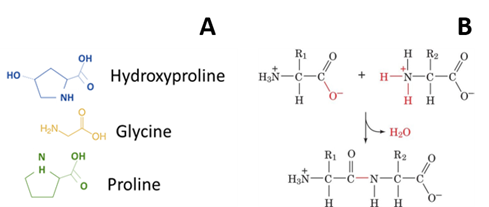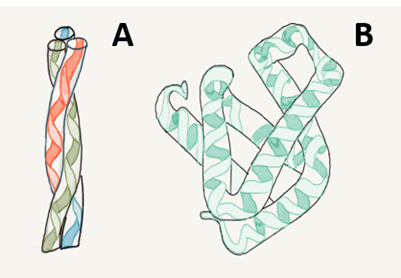Introduction: Protein types and structure
Proteins are essential components of tissues; in fact, they are the organic molecules more abundant in cells (50% of the dried matter of most cell types are proteins). Proteins play an essential role in both function and structure of the cells. Proteins are biopolymers that contain amino acids, the building blocks of proteins, 20 different alpha-amino acids are commonly found in proteins. In the case of collagen, the most frequent ones are shown in Figure 1A, Proline and Hydroxyproline not being alpha-amino acids. Amino acids in the protein are linked by covalent bonds, peptide bonds, between the carboxyl group of one amino acid and the alpha-amino group of other amino acids (Figure 1B).

Figure 1. Structure of the most frequent amino acids in collagen (A). Peptide bond formation (B)
Proteins can be classified into two main types: (i) Fibrous proteins: constituted by polypeptide chains ordered in a parallel fashion along an axis, forming long fibers or sheets (Figure 2A); (ii) Globular proteins: constituted by folded polypeptide chains with spheric or globular shapes (Figure 2B). Fibrous proteins are physically resistant, insoluble in water or salt solutions. They are basic elements in structural tissues such as the connective tissue, skin, bones, and tendons. One of the most important ones is collagen.

Figure 2. Structure of a fibrous (A) and a globular protein (B).
